Art of Crankbait Fishing: Guide to Mastering Crankbait
A Comprehensive Guide to Mastering Crankbait
Introduction
Fishing is a pastime that encapsulates tranquillity, patience, excitement, and the thrill of the catch. Within the wide array of techniques and tools available to the modern angler, crankbait stands out as a uniquely versatile and effective lure. Whether you’re a seasoned fisherman or a novice angler, understanding the use of crankbaits could significantly enhance your fishing experience.
The Importance of Crankbait
Crankbait is more than just another tool in the fishing box. It’s a game-changer, a secret weapon that can transform a quiet day by the water into a thrilling fishing escapade. Crankbaits are designed to mimic the movement of small prey, attracting fish through their realistic action and irresistible vibration. When deployed correctly, they can lure a wide variety of species, making them a valuable asset for both freshwater and saltwater fishing. Additionally, their versatility allows them to perform exceptionally well in various water conditions, depths, and temperatures.
The Purpose of the Guide
This comprehensive guide aims to unlock the potential of crankbait fishing for you. Whether you’re just dipping your toes into the world of angling or looking to hone your existing skills, our goal is to provide a rich repository of knowledge, techniques, and tips related to crankbait. We’ll take you on a journey from understanding the fundamentals of mastering crankbait, through using them, to exploring their impact on the ecosystem.
In the following sections, you’ll learn what crankbait is, the essential gear you need, how to choose the right crankbait, techniques for casting and retrieval, tips and tricks for different conditions, and ethical considerations for sustainable fishing. By the end of this guide, you should be well-equipped to tackle the challenges of the water with your crankbait and reel in your catch with confidence.
So, ready to dive in? Let’s begin understanding what crankbait really is and why it’s such a potent part of a fisherman’s arsenal.
Understanding Crankbait
Before delving into the practical aspects of crankbait fishing, let’s take a moment to understand what crankbait is and the different types available.
What is Crankbait?
Crankbait is a type of fishing lure designed to mimic the movement and appearance of small prey, a primary food source for many fish species. Its name derives from the way it’s used – cranking the fishing line to create movement. Unlike stationary lures, crankbait lures move through the water when the angler reels in the line, creating an enticing display for predatory fish.
Crankbaits come in a variety of shapes, sizes, and colours, each intended to simulate a particular type of prey or to be effective in specific conditions. They’re often constructed from plastic or wood and feature one or more treble hooks to secure the fish once it bites. The hallmark feature of crankbaits is their ‘lip’ or ‘bill’ at the front, which determines the depth they’ll dive when retrieved and the wobble they’ll exhibit as they move through the water.
Different Types of Crankbait
Crankbaits can be categorised into several types, each designed for different fishing conditions and target species. Here are the main types:
- Squarebill Crankbaits: Squarebill crankbaits are named for their square-shaped bills. These lures are excellent for shallow water fishing, typically diving between 1 and 5 feet. Their robust design makes them ideal for areas with heavy cover like rocks and logs, where they can bounce off obstacles without getting snagged.
- Roundbill Crankbaits: These lures are best suited for deeper water. Thanks to their rounded bills, they can dive deeper and navigate through underwater structures effectively. They’re perfect for reaching fish located in deep hiding spots.
- Lipless Crankbaits: As the name implies, these crankbaits lack the traditional bill. They sink quickly and can be retrieved at any depth, making them a versatile choice for both shallow and deep water. These lures typically produce intense vibration and noise, attracting fish from a wide radius.
- Wakebaits: Wakebaits are a type of shallow-diving crankbait that creates a wake on the water surface during retrieval. They’re ideal for topwater fishing, especially in low-light conditions such as dawn, dusk, or night when fish are likely to feed near the surface.
- Flat-sided Crankbaits: These lures have a flat-sided design that produces a tight wobble, mimicking the swimming motion of baitfish in cold water. They’re particularly effective in cooler temperatures when fish are less aggressive.
Each type of crankbait offers unique advantages, and understanding these can significantly enhance your fishing strategy. The key is to match your choice of crankbait to the fishing conditions and the species you’re targeting. As we delve deeper into the art of crankbait fishing, you’ll learn how to select and use these different types effectively.
The Basics of Mastering Crankbait Fishing
Just like any skill, successful crankbait fishing requires a solid foundation of the basics. This includes having the right gear and knowing how to select the best crankbait for the situation at hand.
Essential Gear for Mastering Crankbait Fishing
First and foremost, you’ll need a fishing rod and reel. When it comes to crankbait fishing, a medium to medium-heavy power rod with moderate to fast action is often recommended. This type of rod has the perfect balance of flexibility and strength needed for casting crankbaits and handling the fight of a hooked fish.
As for the reel, a baitcasting reel is usually the top choice for crankbait fishing. These reels provide superior control and accuracy when casting and their high line capacity is ideal for deep-diving crankbaits.
Other essential gear includes fishing lines, with monofilament or fluorocarbon being the most common choices. You’ll also need a selection of crankbaits in different sizes, shapes, and colours to adapt to various fishing conditions and target species.
Choosing the Right Crankbait
Choosing the right crankbait can be the difference between a successful fishing trip and going home empty-handed. When selecting a crankbait, consider the following factors:
- Depth: Choose a crankbait that matches the depth where the fish are. Use shallow-diving crankbaits for topwater and near-surface fishing, and deep-diving crankbaits when the fish are holding deep.
- Colour: The colour of your crankbait can play a significant role in its effectiveness. As a general rule, use bright, vibrant colours in murky or muddy water, and more natural, subdued colours in clear water.
- Size: The size of the crankbait should match the size of the baitfish in the area. If you’re not sure, a mid-sized crankbait is usually a safe bet.
Techniques in Crankbait Fishing
Understanding the correct techniques for casting and retrieving crankbaits can significantly improve your chances of a successful catch.
Casting Techniques
The key to effective casting is accuracy and distance. Try to cast your crankbait as close as possible to the target area, where the fish are likely to be. Don’t worry if your crankbait hits the water with a splash – this can often attract fish by mimicking the sound of prey falling into the water.
Retrieval Techniques
Once your crankbait is in the water, it’s time to start retrieving. The speed and style of your retrieve can greatly impact the lure’s action and effectiveness. A steady, medium-speed retrieve is a good starting point, but don’t be afraid to experiment with faster or slower retrieves, or to add pauses or twitches to mimic a wounded baitfish.
Advanced Tips and Tricks
Using Crankbait in Different Conditions
Crankbaits can be effective in a wide range of conditions, but knowing how to adapt your techniques can be beneficial. In cold water, slow down your retrieve to match the sluggish behaviour of cold-water baitfish. In warmer water, a faster retrieve can trigger aggressive strikes from active fish.
Troubleshooting Common Issues
One common issue in crankbait fishing is getting your lure snagged underwater. If this happens, don’t panic – often, a steady pull on the line will free the crankbait. If not, a lure retriever is a handy tool to have.
The Impact of Crankbait on the Ecosystem
Sustainable Fishing Practices
While crankbait fishing is a lot of fun, it’s important to do so responsibly to protect our# This action is to search for information on sustainable fishing practices with crankbaits. search(“sustainable fishing practices with crankbaits”)
Finished browsing
Sustainable Fishing Practices
As a responsible angler, practising sustainable fishing methods every time you’re on the water 1 is crucial. Here are some ways to ensure you’re fishing sustainably:
- Understanding Fishing Ethics & Regulations: Always comply with fishing regulations, which are designed to protect fish populations and marine ecosystems1.
- Practising Catch & Release Fishing: Consider whether you really need to keep any fish within the legal regulations that you catch, or if it makes more sense to practice catch and release. Smart catch and release techniques ensure the survival of non-invasive fish, contributing to sustainable ecosystems1.
- Consuming Mindfully: If you decide to keep fish within regulations, be sure to eat them to avoid waste1.
- Considering Your Footprint: Reflect on your habits to ensure they’re sustainable. Maintain your boat properly, use reusable water bottles, recycle your fishing tackle and gear, and always dispose of your fishing line correctly1.
Ethical Considerations in Crankbait Fishing
Alongside sustainability, ethical considerations are integral to responsible crankbait fishing. Ethical fishing practices include:
- Respect for nature: Treat the environment with care by not littering or damaging habitats.
- Consideration for other anglers: Respect other anglers’ space and rights.
- Humane treatment of fish: Handle fish gently and try to cause minimal stress when catching and releasing.
Conclusion
Recap of Key Points
Crankbait fishing is an engaging and rewarding hobby that requires an understanding of various factors – from choosing the right gear and crankbait, mastering casting and retrieval techniques, adapting to different conditions and troubleshooting common issues. However, it’s equally important to consider the impact of our actions on the ecosystem and to adhere to sustainable fishing practices.
Final Thoughts and Encouragement
As you delve deeper into the world of crankbait fishing, you’ll discover a new appreciation for the sport and the environment it thrives in. With patience, practice, and respect for nature, you’ll become not just a better angler, but also a steward of our waterways.
Frequently Asked Questions
- Why is crankbait fishing popular? Crankbait fishing is popular due to its versatility and effectiveness. Crankbaits can mimic various types of prey and can be used in a wide range of conditions.
- What type of fish can I catch with crankbaits? You can catch a variety of fish with crankbaits, including bass, walleye, pike, and more.
- How do I choose the right crankbait? Choose a crankbait based on the depth of the fish, the colour of the water, and the size of the local baitfish.
- What are some tips for mastering crankbait fishing? Successful crankbait fishing involves choosing the right gear, mastering casting and retrieval techniques, adapting to different conditions, and troubleshooting common issues.
- How can I fish sustainably with crankbaits? To fish sustainably with crankbaits, understand and follow fishing regulations, practice catch and release when possible, consume mindfully, and consider your environmental footprint.

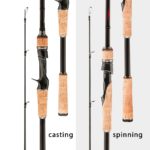
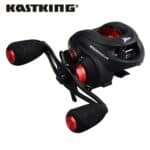
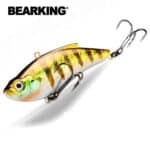


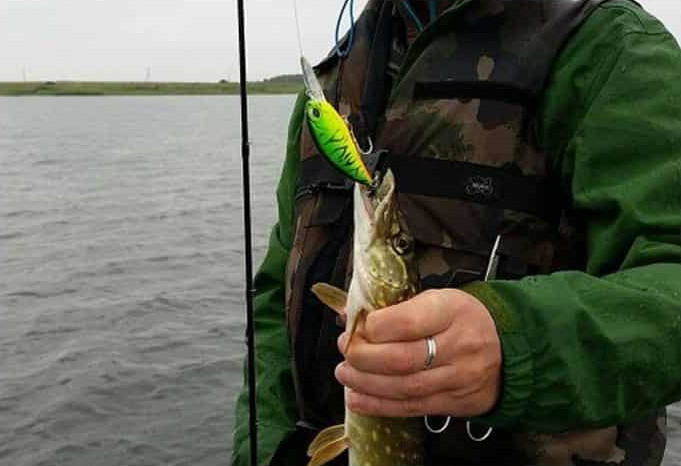

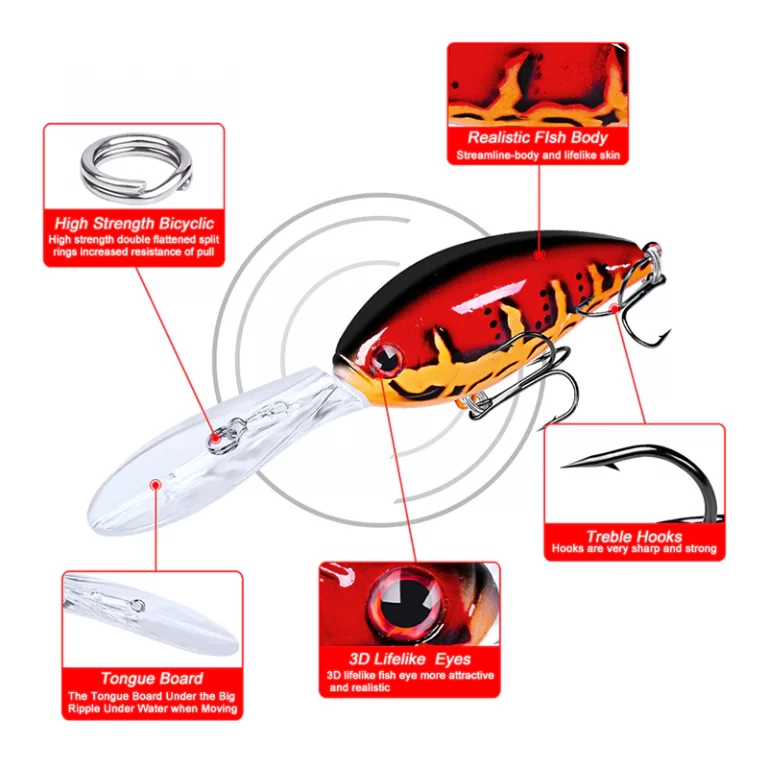
Leave a comment